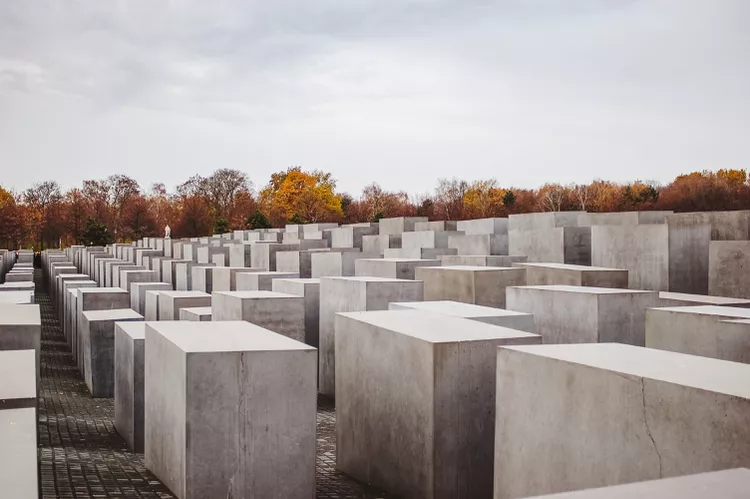Summary of the Holocaust Memorial in Berlin
Holocaust Memorial in Berlin
The Denkmal für die ermordeten Juden Europas (Memorial to the Murdered Jews of Europe) is one of the most evocative and controversial monuments to the Holocaust. Located in the center of Berlin between Potsdamer Platz and the Brandenburg Gate, this impressive site sits on 4.7 acres. Every step of its development has been contentious – not unusual for Berlin – yet it is a vital stop on a Berlin tour.
The Architect of the Holocaust Memorial in Berlin
The American architect Peter Eisenmann won the project in 1997 after a series of competitions and disagreement about what was an appropriate design for such an important memorial. Eisenmann has said:
The enormity and scale of the horror of the Holocaust is such that any attempt to represent it by traditional means is inevitably inadequate … Our memorial attempts to present a new idea of memory as distinct from nostalgia … We can only know the past today through a manifestation in the present.
The Design of the Holocaust Memorial in Berlin
The centerpiece of the Holocaust memorial is the “Field of Stelae,” featuring 2,711 geometrically arranged concrete pillars. Visitors can enter at any point and walk through the unevenly sloping ground, occasionally losing sight of companions and the busy city. The solemn columns, all different in size, evoke a disorienting feeling that visitors can only experience when navigating this gray forest of concrete. The design aims to elicit feelings of isolation and loss, which is particularly suitable for a Holocaust memorial.
Among the more contentious decisions was the choice to apply a graffiti-resistant coating. Eisenman opposed it, arguing for artistic integrity, yet there were valid concerns about potential vandalism from neo-Nazis. Furthermore, the Degussa company responsible for creating the coating had ties to the National-Socialist persecution of Jews, and their subsidiary produced Zyklon B, the gas used in extermination camps.
Conduct at the Holocaust Memorial in Berlin
Recently, there have been critiques regarding the behavior of visitors. While exploration of the site is encouraged, standing on the stones, running, or engaging in general merry-making is discouraged by guards. Additionally, Jewish artist Shahak Shapira initiated a parody project called Yolocaust that highlights disrespectful visitor behavior.
Museum at the Holocaust Memorial in Berlin
To address observations that the memorial lacked personal stories, an information center was added below the monument. Entrance is located on the eastern border, and visitors should be prepared for security checks.
The museum hosts an exhibition detailing Nazi terror in Europe through multiple rooms covering various historical aspects. It projects the names of Jewish Holocaust victims, sourced from Yad Vashem, on the walls while a short biography is narrated. An interactive database is also available for those wishing to learn more.
All texts within the exhibition center are provided in English and German.
Visitor Information for the Holocaust Memorial in Berlin
- Address: Cora-Berliner-Straße 1, 10117 Berlin
- Getting to the Holocaust Memorial: Metro Stop: “Potsdamer Platz” (line U2, S1, S2, S25).
- Admission: Free admission, donations are appreciated.
- Guided Tours: Free tours Saturday at 15:00 (English) and Sunday at 15:00 (German); 1.5-hour duration.
Other Holocaust Memorials in Berlin
Upon the erection of the memorial, controversy arose over its singular focus on Jewish victims, as many groups suffered during the Holocaust. Other memorials have been established to honor their memories:
- Memorial to Homosexuals Persecuted Under Nazism – Located just across the street, this structure reflects the larger memorial’s design with a focus on the many homosexual victims.
- Memorial to the Sinti and Roma Victims of National Socialism – The newest Holocaust memorial commemorates the 20,000 to 500,000 people murdered in the Porajmos.
- Stolpersteine – Subtle gold plaques dot the sidewalks where individuals were forced from their homes and sent to concentration camps. The “stumbling stones” serve as an inclusive memorial for all victims of the Nazi regime.
- Hitler’s Bunker – The site of Hitler’s last days, known more for its historical significance than for being a memorial, features a simple information board detailing its history.





